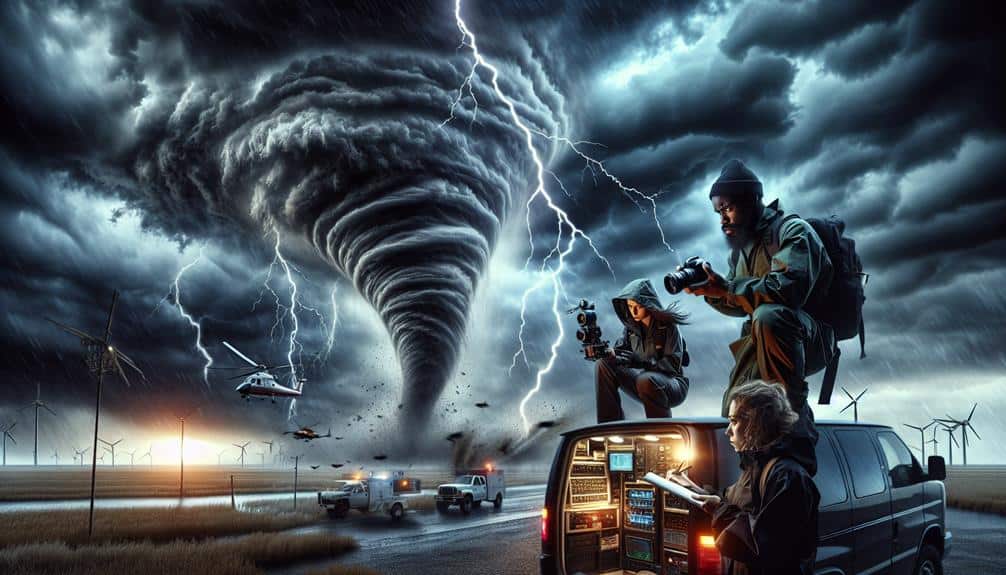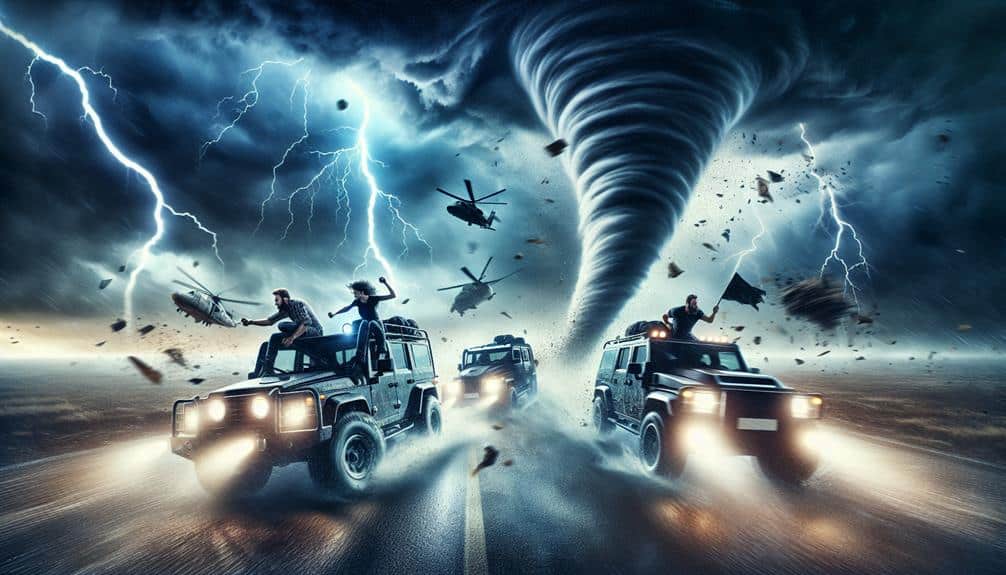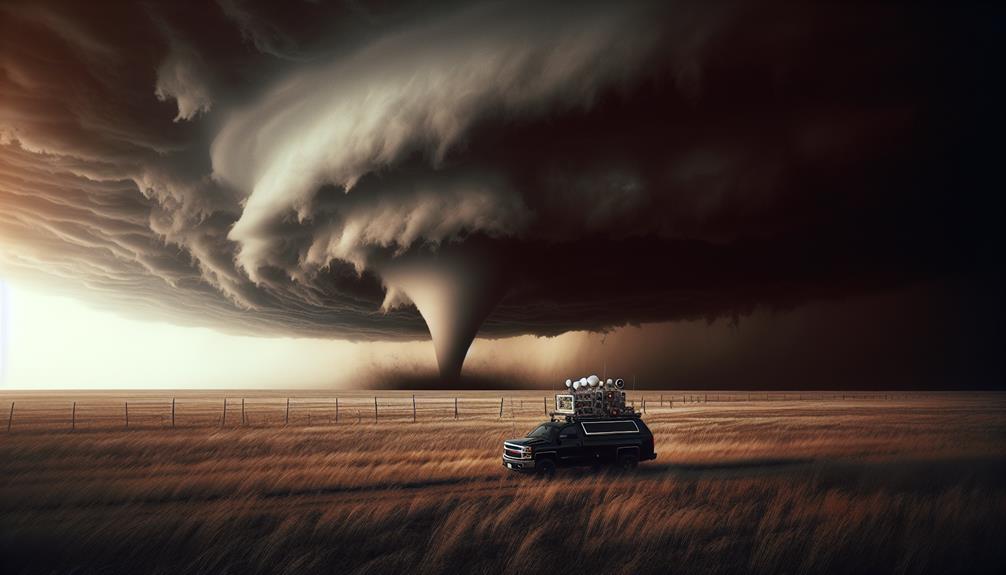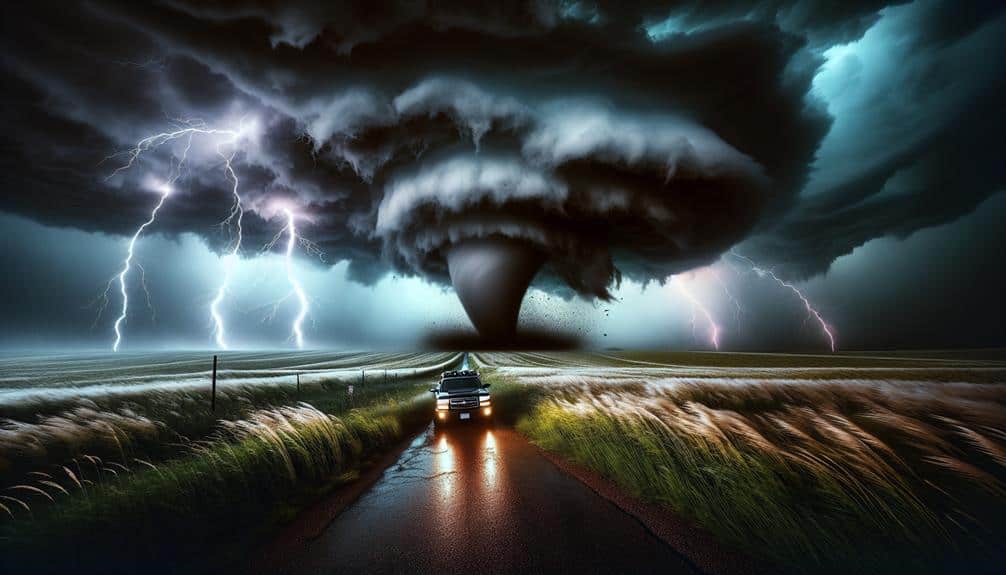We explore storm chasing as both an exciting adventure and a scientific endeavor, where meticulous data collection improves our understanding of severe weather. Rising global temperatures, intensified by climate change, fuel more powerful storms and unpredictable weather patterns. Observations from storm chasers contribute essential information to climate research, enriching our predictive capabilities. Advances in drone technology and AI models enhance both safety and accuracy in storm tracking. Analyzing these interconnections offers crucial insights into how climate change impacts storm formation and severity. Embracing these insights will enable us to better grasp the complexities of our evolving climate.
Key Points
- Storm chasing gathers crucial data on severe weather patterns, aiding climate research.
- Climate change is causing more intense storms due to rising global temperatures and warmer oceans.
- Advanced technologies like drones and AI enhance the safety and accuracy of storm chasing.
- Historical and real-time data collection improves predictive capabilities and disaster preparedness.
The Thrill of Storm Chasing
Storm chasing offers a unique combination of exhilaration and scientific inquiry, attracting both thrill-seekers and researchers alike. The adrenaline rush we experience as we track a powerful storm is matched only by the valuable data we collect. Each pursuit is a delicate balance between the excitement of witnessing nature's raw power and the disciplined application of safety precautions.
Quantitative data reveal that storm chasers can clock wind speeds exceeding 100 miles per hour and observe hailstones larger than golf balls. These measurements aren't just thrilling; they're necessary for advancing our understanding of severe weather patterns. However, it's crucial to underscore the importance of safety precautions. Proper training, reliable communication equipment, and real-time weather updates are non-negotiable. Statistics show that chasers who adhere to these guidelines significantly reduce their risk of injury.
Our freedom to explore these natural phenomena comes with the responsibility to respect their unpredictability. By rigorously preparing and staying informed, we make sure that our storm-chasing endeavors are as safe as they're exhilarating. In doing so, we not only satisfy our quest for adrenaline but also contribute valuable insights to the scientific community.
Climate Change and Extreme Weather
As we examine the link between climate change and extreme weather, we see rising global temperatures contributing to more frequent and severe weather events.
Data indicate that warmer oceans and atmosphere intensify storms, leading to increased instances of hurricanes, tornadoes, and heatwaves.
It's vital to understand these patterns to better predict and mitigate their impacts.
Rising Global Temperatures
Global temperatures have risen by about 1.2 degrees Celsius since the late 19th century, adding to the frequency and intensity of extreme weather events. This increase in temperature has accelerated the melting of icecaps, which in turn disrupts ocean currents vital for regulating our climate. As these currents shift, we experience more unpredictable weather patterns, contributing to the rise in extreme events.
Warmer atmospheric conditions also exacerbate drought conditions in various regions. These prolonged dry spells not only deplete water resources but also create the ideal environment for wildfires to ignite and spread rapidly. In recent years, we've observed devastating wildfires in places like California and Australia, highlighting the direct link between rising temperatures and fire hazards.
The data makes it clear: our planet is warming, and the cascading effects are undeniable. As we analyze these trends, we need to focus on how they impact our weather systems and our daily lives. Understanding these changes is vital for developing strategies to mitigate and adapt to the new climate reality, ensuring our freedom to live resiliently and sustainably in a world with rising global temperatures.
Intensified Weather Patterns
The increasing frequency and intensity of extreme weather events, such as hurricanes and tornadoes, are directly linked to the changing climate. Scientific data show a marked rise in sea surface temperatures, fueling more powerful storms. These intensified weather patterns strain our weather forecasting capabilities and necessitate improved disaster preparedness strategies. We must harness advanced technology to predict these events with greater accuracy, providing communities more time to prepare and reduce potential damage.
Meteorological studies indicate a 30% increase in Category 4 and 5 hurricanes over the past four decades. This uptick demands robust emergency response systems. Communities must invest in resilient infrastructure, ensuring they can withstand the onslaught of severe weather. Data-driven approaches to building codes and zoning laws can mitigate the impact of flooding and high winds.
Community resilience depends not just on physical preparedness but also on social cohesion. Strong networks enhance our ability to recover from disasters. When we support each other, we strengthen our collective capacity to face future challenges. By focusing on these areas, we empower ourselves to live freely and securely in an era of unpredictable, intensified weather patterns.
The Science Behind Storms

Understanding the formation and behavior of storms requires analyzing atmospheric data, weather patterns, and the complex interactions between different meteorological elements. To comprehend storm formation, we must consider key atmospheric conditions like temperature, humidity, and wind patterns. These factors interact to create varying types of storms, from thunderstorms to hurricanes.
For instance, warm ocean waters fuel tropical storms, while cold, dry air interacting with warm, moist air can lead to severe thunderstorms.
Storm tracking is critical for predicting the path and potential impact of these weather events. We rely on data collection from satellites, radar systems, and ground-based weather stations. These tools provide real-time information on storm development, allowing meteorologists to model and forecast storm behavior with increasing accuracy.
By analyzing historical weather patterns alongside current atmospheric conditions, we can identify trends and make more informed predictions.
Our ability to track and understand storms not only aids in preparing for their impacts but also enhances our knowledge of broader climatic changes. As we continue to gather and analyze data, we improve our predictive capabilities and deepen our understanding of the atmospheric dynamics that drive these powerful natural phenomena.
Popular Storm Chasing Documentaries
Storm chasing documentaries offer an engaging and data-rich perspective through which we can examine the behaviors and effects of severe weather phenomena. Through documentary analysis, we gain valuable insights into the complexities of storm chasing, including the inherent dangers and the environmental impact.
Documentaries like 'Tornado Alley' and 'Chasing Ice' showcase the thrilling yet risky pursuit of storms. These films often feature storm chaser interviews that provide first-hand accounts of the challenges faced during their expeditions.
By closely analyzing these documentaries, we can identify patterns in storm behavior and enhance our understanding of meteorological events. The interviews with storm chasers offer important data, revealing both the human and scientific aspects of storm chasing. However, it's important to highlight the storm chasing risks emphasized in these films.
The dangers aren't only to the storm chasers themselves but also to the environment, as increased activity can result in unintended ecological disruptions. Furthermore, these documentaries underscore the broader environmental impact of severe weather, often worsened by climate change.
They serve as a stark reminder of the delicate balance between human curiosity and nature's raw power, prompting us to acknowledge the consequences of our pursuits.
Profiles of Notable Storm Chasers

Let's examine the key figures in storm chasing by looking at pioneers in the field, modern techniques they employ, and their contributions to climate research.
We'll analyze how their work has evolved over time and the impact it has on our understanding of severe weather patterns.
Pioneers in Storm Chasing
Prominent figures such as David Hoadley and Tim Samaras have greatly advanced the field of storm chasing through their groundbreaking research and innovative techniques.
David Hoadley, often considered one of the early storm chasers, began documenting severe weather phenomena in the 1950s. His meticulous record-keeping and photography set the stage for modern storm chasing, offering invaluable data to meteorologists and researchers.
Tim Samaras, another significant name in storm chasing history, revolutionized our understanding of tornadoes. He developed unique instruments capable of measuring atmospheric pressure drops inside tornadoes, contributing to safer and more precise forecasting. Samaras' work exemplifies the dedication and scientific rigor that have come to define this field.
We can't overlook the contributions of other notable figures like Roger Jensen and Neil Ward, who also played critical roles in the development of storm chasing. Their collective efforts have laid the foundation for today's advanced methodologies.
Modern Storm Chasing Techniques
Building on the foundational work of early pioneers, today's storm chasers utilize advanced technologies such as Doppler radar, drones, and high-definition satellite imagery to predict and analyze severe weather events with unparalleled accuracy. Modern storm chasing techniques have greatly evolved, enhancing our abilities in storm tracking and storm prediction.
Drone technology plays an essential role, allowing us to gather data from within storm systems without risking human lives. Equipped with sensors and high-definition cameras, drones offer real-time insights into storm dynamics. This data collection is pivotal for improving predictive models and understanding storm behavior.
Notable storm chasers like Reed Timmer and Sean Casey have leveraged these advancements. Timmer's use of customized vehicles equipped with state-of-the-art instruments enables precise data collection, while Casey's IMAX films provide an educational perspective. Their contributions have led to more precise storm tracking and better-informed public safety measures.
High-definition satellite imagery complements ground-based observations, providing a broader view of storm systems. Together with Doppler radar, these tools enable us to refine storm prediction algorithms, offering earlier and more dependable warnings.
Contributions to Climate Research
Storm chasers like Reed Timmer and Sean Casey have greatly contributed to climate research by providing critical data and insights on severe weather patterns. Through their field observations, they've enabled us to understand the intricacies of storm formation and behavior. Timmer, renowned for his aggressive storm-chasing tactics, has collected invaluable real-time data. His data analysis has been instrumental in refining predictive models and improving early warning systems.
Casey, on the other hand, has combined storm chasing with filmmaking, documenting extreme weather conditions through his IMAX films. His field observations haven't only captivated audiences but have also provided researchers with visual data that's difficult to obtain through conventional methods.
Both Timmer and Casey have equipped their vehicles with advanced meteorological instruments, capturing detailed measurements of wind speed, temperature, and atmospheric pressure. This hands-on approach yields high-resolution data that satellites and stationary weather stations can't always provide.
Their contributions have spurred advancements in our understanding of climate dynamics and severe weather phenomena. By integrating their findings with broader climate studies, we've gained a clearer picture of how climate change may be influencing the frequency and intensity of storms. Their work underscores the importance of direct data collection and rigorous analysis in climate research.
Future of Storm Chasing
As we look ahead, advancements in technology and data analytics will revolutionize the practice of storm chasing, offering unprecedented accuracy and safety. With cutting-edge radar systems, drones, and AI-driven models, we'll be able to predict storm paths with remarkable precision. However, these technological advancements also bring ethical concerns. The use of drones, for instance, raises questions about privacy and the potential for misuse.
Incorporating advanced safety precautions is crucial. Real-time data feeds and improved communication systems will allow us to make informed decisions quickly. The integration of wearable tech that monitors our essential signs can enhance our safety during intense chases.
Despite these innovations, we must remain vigilant about the environmental impact of our activities. Increased vehicular emissions and potential disturbances to natural habitats are significant considerations.
Moreover, as climate change continues to influence weather patterns, storm chasing will require adaptive strategies. We must balance our quest for data with the responsibility to protect the environment. Our pursuit of freedom and exploration shouldn't come at the cost of ethical and environmental standards. By prioritizing sustainable practices, we can ensure that storm chasing remains both thrilling and responsible.
Frequently Asked Questions
What Equipment Do Storm Chasers Typically Carry for Safety and Data Collection?
We carry emergency supplies, technology like GPS and radar, and equipment for data analysis and forecasting. Our gear guarantees safety and provides precise data collection, empowering us to navigate and analyze severe weather conditions effectively.
How Can Someone Get Started in Storm Chasing as a Hobby or Career?
To start storm chasing, we should study chasing techniques, weather patterns, and risk assessment. Gaining knowledge in emergency response is essential. Joining a local storm chasing group or taking meteorology courses helps us build a solid foundation.
What Are the Legal Restrictions or Permits Required for Storm Chasing?
For the Current Question, we must understand there aren't specific permit requirements for storm chasing. However, we should adhere to local legal restrictions, including traffic laws and property access rights, to guarantee safety and compliance.
How Do Storm Chasers Communicate and Coordinate During a Chase?
We use multiple communication methods and coordination techniques to guarantee everyone's safety during a storm chase. By adhering to strict safety protocols and employing advanced data analysis techniques, we effectively track storms and share real-time information.
What Training or Education Is Recommended for Aspiring Storm Chasers?
Remember when we learned to swim before diving into the deep end? Aspiring storm chasers should take meteorology courses and gain hands-on experience. Safety protocols and emergency response training are essential for maneuvering the unpredictable nature of storms.


